Do you often find that your eyelids feel inflamed or irritated? There are a variety of minor conditions that can affect your eyes, from dry eyes to allergies.
One common eye condition is blepharitis. Blepharitis causes inflammation of the eyelids and can also affect your eyelashes and ability to produce tears.
Blepharitis can occur due to several factors, and while it can be irritating, it may not cause any significant problems at first. However, if left untreated, blepharitis can cause more concerning complications.
Luckily, there are ways to treat blepharitis, give your eyes relief from irritation, and prevent further issues. Keep reading to learn more about the treatments available for treating blepharitis!
What is Blepharitis?

The term “blepharitis” means that someone has eyelid inflammation. There are two kinds of blepharitis: anterior blepharitis and posterior blepharitis.
These two different kinds of blepharitis are categorized based on where the inflammation is. Anterior blepharitis occurs on the outside of the eyelids near the eyelashes. Posterior blepharitis occurs on the inner edge of the eyelids that are more closely connected to the eye.
Usually, anterior blepharitis occurs because of a bacterial infection. But posterior blepharitis is generally caused by inflammation of the meibomian glands.
The meibomian glands produce the oils that are a necessary component in your tears. Both result in similar symptoms, including red, swollen, and watery eyes and itchiness around the eyes. Often, eyelashes and eyelids become crusty and may stick together.
Blepharitis can result from many things, including a skin condition, allergies, dry eye syndrome, eyebrow mites, skin infection, and clogged meibomian glands. Clogged glands often directly result in both dry eye syndrome and posterior blepharitis.
Blepharitis symptoms can be very uncomfortable. They also can lead to the development of other symptoms.
Complications
It’s essential to treat blepharitis. Treating blepharitis will help to relieve your symptoms and to prevent further complications from occurring.
Having inflamed eyelids for an extended time can lead to dry eyes, loss of eyelashes, and even injury caused by eyelashes stuck together rubbing against the eye.
It can also lead to styes. Styes are an infection that causes a painful bump to form on the eyelid. Not only can a stye be painful, but it can block your vision if it develops on the upper eyelid.
Sometimes, blepharitis is minor and can be taken care of on your own. But more severe cases require prescribed treatment from your eye doctor.
When to See Your Eye Doctor to Treat Blepharitis

You should see an eye doctor if you experience symptoms that don’t improve over a few days. Sometimes, minor cases of blepharitis can be relieved by using home remedies.
You should see your eye doctor before attempting home remedies if you’ve had symptoms for a long time and they are not getting any better. They can recommend what treatments are best.
When you see your eye doctor for blepharitis symptoms, they can often diagnose the condition by examining your eyelids. If your symptoms are severe, they may take a swab to check for a bacterial infection.

Once diagnosed, your ophthalmologist will recommend treatment. They may advise you to start with home remedies at first and prescribe medication if your symptoms persist.
Treating Blepharitis
There are several treatments that your eye doctor can recommend. Often, the best way to treat blepharitis is to clean your eyes.
If you clean your eyes daily, you may find that your symptoms begin to go away and improve. But you need to be careful to wash your eyes as directed by your eye doctor.
Massage Your Eyelids
Your eye doctor will likely suggest that you start treating blepharitis by massaging your eyelids. The easiest way to do this is by putting a warm, wet compress over them while they are closed and then pressing it against your eyes.
Then they’ll tell you what kind of solution to use to clean the outside of your eyelids with a cotton swab or washcloth. There are over-the-counter cleaning solutions you can buy, but you may also be able to make your own solution by diluting baby shampoo with water.

Be sure to ask your eye doctor what’s safe to use before you begin cleaning your eyes. Other home remedies include dandruff shampoo, over-the-counter artificial tears, and tea tree oil.
Consider Using Tea Tree Oil
Tea tree oil is a natural anti-inflammatory, but you should ask your eye doctor before using it, as it may be too intense for some patients. Your eye doctor may prescribe stronger medications if these home remedies and over-the-counter medications don’t relieve your symptoms.
Prescription Antibiotic Eye Drops
Antibiotics are often an effective way to treat bacterial infections if they are causing blepharitis. They may be administered as eye drops.
Oral Antibiotics
If antibiotic eye drops don’t help, your eye doctor may prescribe antibiotics that are taken orally. In more severe cases of blepharitis, steroids can also be used as an anti-inflammatory.
Taking Topical Cyclosporine
Sometimes, blepharitis is caused by an immune response triggered by allergies. Topical cyclosporine may be effective in these cases as it’s a medication that suppresses the immune system.
Which medications will work best for you depends on how severe your blepharitis is, what triggered it, and your symptoms. If your eye doctor cannot identify the cause, they may want to try several different treatments to determine which one is most effective.

Treat the Underlying Condition Causing Blepharitis
If your blepharitis is due to an underlying condition like having rosacea, treating the first condition is often the best solution. But no matter how severe your symptoms may be or what’s causing your blepharitis, treatment can help you get the relief you need.
Do the symptoms of blepharitis sound familiar to you? Schedule an appointment at Sierra Nevada Eye Center in Reno, NV, and get on the path to relief from your symptoms!


